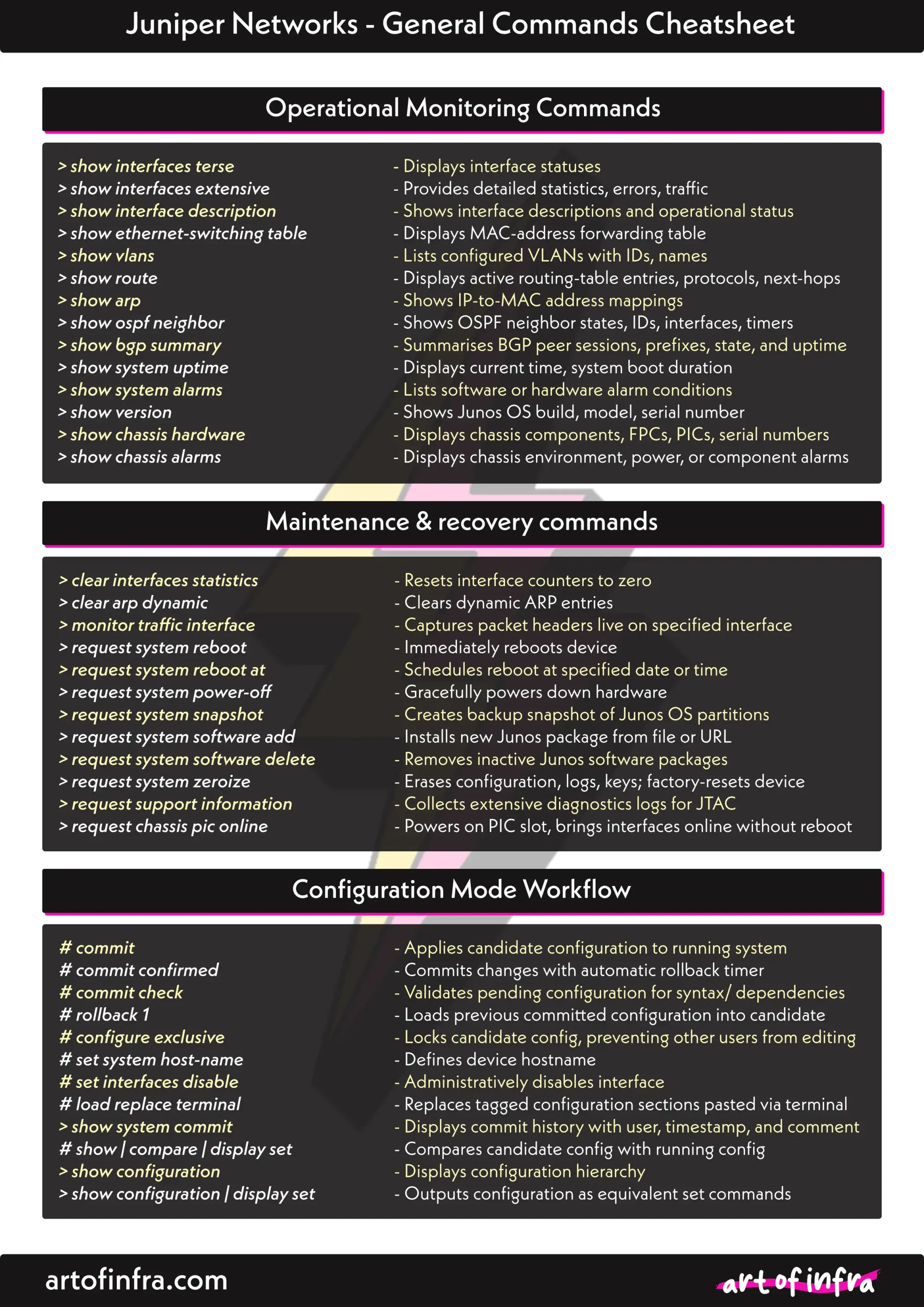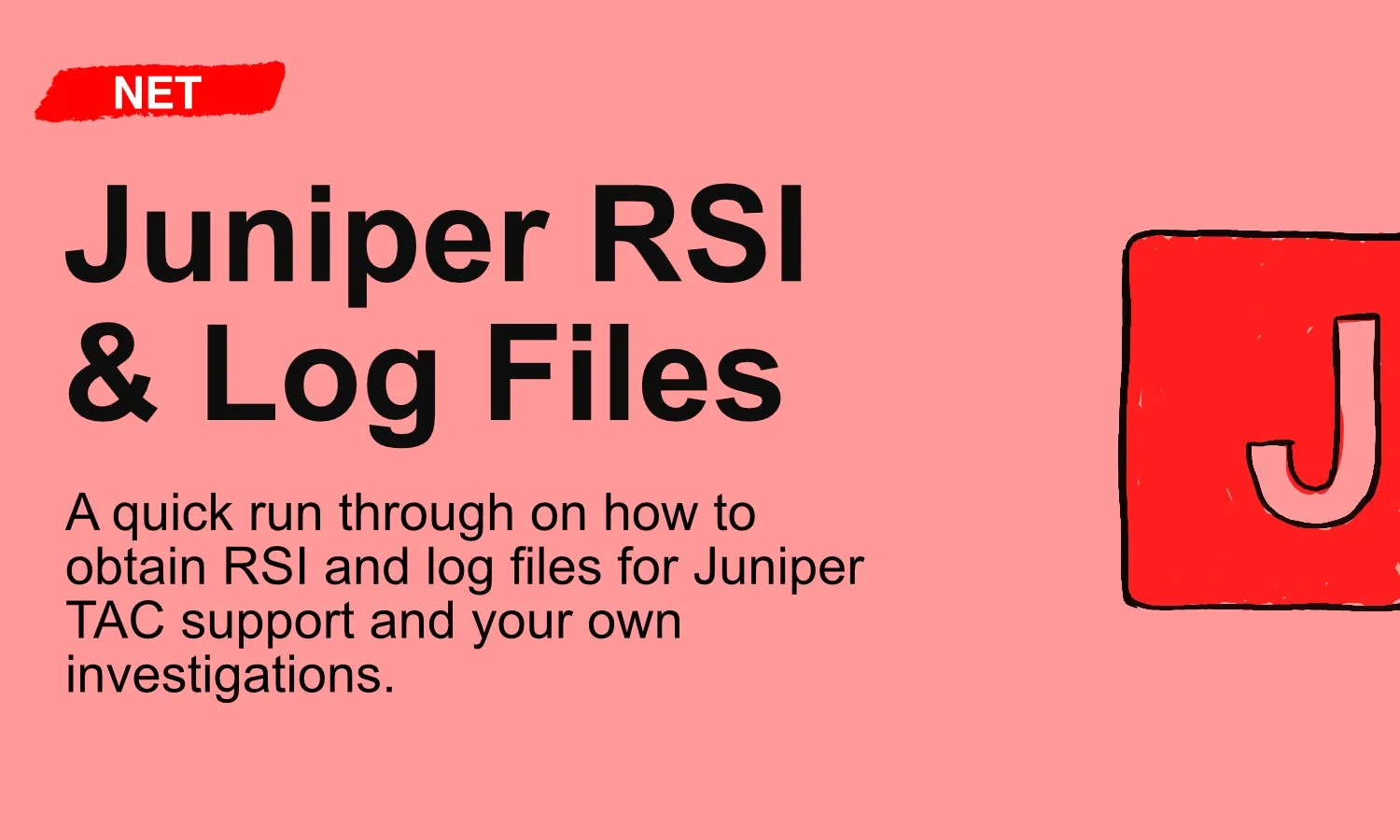I've put together some of the most used commands you'll use when working with Juniper Networks equiment.
Below, you'll find the commands in code-blocks as well as a nifty PDF that you can print off to hang on your wall and show off to all your friends! (if thats your thing)

Operational monitoring commands
> show interfaces terse
-- Displays interface statuses and IPs.
> show interfaces extensive
-- Provides detailed statistics, errors, traffic, and physical interface information.
> show interface description
-- Shows interface descriptions and operational status.
> show ethernet-switching table
-- Displays MAC-address forwarding table.
> show vlans
-- Lists configured VLANs with IDs, names, and membership port counts.
> show route
-- Displays active routing-table entries, protocols, next-hops, preferences, current metrics values.
> show arp
-- Shows IP-to-MAC address mappings learned for Layer-3 neighbour resolution table.
> show dhcp binding
-- Displays DHCP bindings with lease times, MACs, and addresses allocated.
> show ospf neighbor
-- Shows OSPF neighbour states, IDs, interfaces and timers.
> show bgp summary
-- Summarises BGP peer sessions, prefixes, state and uptime.
> show system uptime
-- Displays current time, system boot duration, and protocol uptime statistics.
> show system alarms
-- Lists software or hardware alarm conditions.
> show system processes extensive
-– Displays CPU usage, memory, and state of all system processes.
> show version
-- Shows Junos OS build, model, serial number, and software versions.
> show chassis hardware
-- Displays chassis components, FPCs, PICs, serial numbers, and hardware inventory.
> show chassis alarms
-- Displays chassis-level environmental, power, or component alarms.
> show chassis routing-engine
-- Shows routing-engine CPU, memory, temperature, uptime, mastership information status details.
Maintenance & recovery commands
> clear interfaces statistics
-– Resets interface counters to zero.
> clear arp dynamic
-- Clears dynamic ARP entries forcing refresh of Layer-3 neighbour cache.
> monitor traffic interface
-- Captures packet headers live.
> request system reboot
-- Immediately reboots device software, preserving configuration and triggering full restart.
> request system reboot at
-- Schedules reboot at specified date or time.
> request system power-off
-- Gracefully powers down hardware, ensuring safe shutdown.
> request system snapshot
-- Creates backup snapshot of Junos OS partitions for recovery purposes.
> request system software add
-- Installs new Junos package from file or URL onto device.
> request system software delete
-- Removes inactive Junos software packages, freeing storage space for upgrades.
> request system zeroize
-- Erases configuration, logs, keys; factory-resets device and reboots cleanly after.
> request support information
-- Collects extensive diagnostics logs for JTAC support and troubleshooting.
> request chassis pic online
-- Powers on PIC slot, bringing interfaces online without chassis reboot.Configuration-mode workflow
# commit
-- Applies candidate configuration changes to running system, activating new settings.
# commit confirmed
-- Commits changes with automatic rollback timer unless subsequently confirmed again.
# commit check
-- Validates pending configuration for syntax and dependencies without applying changes.
# rollback 1
-- Loads previous committed configuration into candidate.
# configure exclusive
-- Locks candidate configuration, preventing other users from editing until exit.
> edit
-- Navigates to the configuration hierarchy to specified context for set commands.
# set system host-name
-- Defines device hostname.
# set interfaces disable
-- Administratively disables interface, shutting link without removing existing configuration stanza.
# load replace terminal
-- Replaces tagged configuration sections pasted via terminal, overwriting previous values.
# configure private
-- Creates candidate copy allowing concurrent edits without global configuration lock.
> show system commit
-- Displays commit history with user, timestamp, and comment for auditing.
> show configuration
-- Displays configuration hierarchy at current level for review or export.
> show configuration | display set
-- Outputs configuration as equivalent set commands.If you feel additional commands would be handy to have here and help others, please let me know in the comments and I'll ensure to update it.








